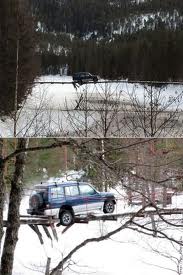Distinguished Science writer Dr. Richard Kerr walked the plank this afternoon in response to this morning’s Knight Science Journalism Tracker inquiry of science writers.
Charles Petit’s casual post brought quick attention from the old-school dean of science writing. Kerr implored his press colleagues to, in effect: Move on, move on…There is nothing to see here.
See here:
I hope the rest of the science media is ignoring the mammoth-killer impact for the same reason I am, because it has been shown there is no science to support it. My September 3, 2010 story in Science, Mammoth-Killer Impact Flunks Out, reported that 3 years after the idea was introduced at the AGU in Acapulco, just about every outside expert who had put their time, money, and energy into checking the evidence in their specialty was thoroughly disgusted with the whole thing. Nothing was checking out. Ordinary materials had been interpreted as evidence of impact. They were washing their hands of it. True, advocates have gotten a couple more papers in PNAS, but a paper by other outsiders recently in PNAS came up with the same years-old conclusion–there is no evidence for impact. End of story, at least for me.
— Richard Kerr, KSJT, June 13, 2012
Richard Kerr of Science
The best that I can say for Dr. Kerr is that he may be trapped in an echo chamber without access to scientific publications.
Precisely to Kerr’s point here is an excerpt from the YDB hypothesis authors themselves in the Lake Cuitzeo paper, published last month in PNAS (and un-reported by Kerr). Note they cite Kerr’s News Focus piece itself, demonstrating that truth must necessarily reference fiction when attacked.
Below is a less formal but informative riff prepared by Mr. Dennis Cox, who was forced by lightly informed geeks to publish his writing in Wiki’s “Talk” section, where you are welcomed to argue it with lightly informed geeks.
It is untrue to assert that there is no supportive evidence. It is also untrue to state that no evidence has been found in Europe, or on other continents. In fact, studies have revealed similar blast materials in YDB aged sediments on three continents. Replication has been achieved, interpretation is still subjective. In Europe: Tian et al, 2010 went searching for diamonds in the YDB (In Europe it is also referred to as the Usselo Horizon) in Belgium. They wrote that “our findings confirm, and in fact reveal more direct proof than the earlier studies, the existence of diamond nanoparticles also in this European YDB layer No such particles are found in the overlying silt and clay or in the underlying fine sands.” Van Hoesel A, Hoek W, Braadbaart F, van der Plicht H, Drury MR. (2011) Nanodiamonds and the Usselo layer. Paper #1556, XVIII INQUA-Congress, 21-27 July 2011 in Bern, Switzerland, reported finding “carbon aggregates [consistent with] nanodiamond” in YD-aged sediments In the Netherlands. Abstract from Marshall W, Head K, Clough R, Fisher A. (2011) Exceptional iridium concentrations found at the Allerød-Younger Dryas transition in sediments from Bodmin Moor in southwest England. Paper #2641, XVIII INQUA-Congress, 21-27 July 2011 in Bern, Switzerland. Elevated iridium values, dated to start of the Younger Dryas cooling event, have been found in sediments deposited at a number of Late Glacial sites in North America and one in Europe. It has been proposed (e.g., Firestone et al., 2007, PNAS 104: 16016-16021) that this widespread iridium enrichment signal is the result of an explosive disintegration of a large extraterrestrial object over North America around 12,900 cal. yr BP, and it is contended that it was this event which instigated the Younger Dryas cooling. This scenario is controversial, and the ‘ET’ explanation of these geochemical signals is not universally accepted. This notwithstanding, we report here the finding of an iridium anomaly in the Allerød-Younger Dryas boundary sediments at Hawks Tor in the southwest of England. The concentration of iridium and other elements is determined in peat monoliths using ICP-MS, operated in collision-cell mode, and ICP-OES instruments. We find an increase of over 300 % in the iridium concentration measured in the bulk sediment immediately above the Younger Dryas boundary compared with the values found below the transition. The iridium-titanium ratio is used to confirm a lag between the start of the iridium enrichment and the timing of abrupt environmental disruption at the site signalled by decreases in the organic carbon content, and changes the concentrations of potassium, iron and manganese. These geochemical changes coincide with a shift from a humified peat to a minerogenic lithology. By using a new calibration of existing 14C ages, integrated with new AMS dates and optically stimulated luminescence ages, we show that the timing of this iridium enrichment found in southwest England is in agreement with the dates proposed for the iridium enrichment signals previously found in North America and Belgium. In Germany: Wolfgang Roesler et al., Carbon Spherules With Diamonds In Soils In South America: Mahaney WC, et al. (2010a) Evidence from the northwestern Venezuelan Andes for extraterrestrial impact: The black mat enigma. Geomorphology, v. 116, iss. 1-2, p. 48-57. Mahaney WC, Krinsley D, Kalm V (2010b) Evidence for a cosmogenic origin of fired glaciofluvial beds in the northwestern Andes: Correlation with experimentally heated quartz and feldspar. Sedimentary Geology, v. 231, iss. 1-2, p. 31-40. Mahaney WC, David Krinsley, Kurt Langworthy, Kris Hart, Volli Kalm, Pierre Tricart and Stephane Schwartz. (2011a) Fired glaciofluvial sediment in the northwestern Andes: Biotic aspects of the Black Mat. Sedimentary Geology. 237, (1-2), pp73-83 Mahaney, WC, Dave Krinsley, James Dohm, Volli Kalm, Kurt Langworthy and J. Ditto. (2011b) Notes on the black mat sediment, Mucunuque Catchment, northern Mérida Andes, Venezuela.. Journal of Advanced Microscopic Research, vol. 6, no. 3. And on the North American Continent Firestone RB, et al. (2007) Evidence for an extraterrestrial impact 12,900 years ago that contributed to the megafaunal extinctions and the Younger Dryas cooling. Proc Natl Acad Sci USA 104:16016–16021. Baker DW, Miranda PJ, Gibbs KE. (2008) Montana Evidence for Extra-Terrestrial Impact Event That Caused Ice-Age Mammal Die-Off. American Geophysical Union, Spring Meeting 2008, abstract #P41A-05. Fayek, M.; Hull, S.; Anovitz, L.; Haynes, V.; Bergen, L. (2008) Evidence of impact material and the extinction of the mega-fauna 12,900 years ago. American Geophysical Union, Fall Meeting 2008, abstract #PP13C-1469. Tankersley K. (2009) “Evidence of the Clovis Age Comet at Sheriden Cave, Ohio.” Midwest Chapter of the Friends of Mineralogy Symposium and Field Conference (Geology Department of Miami University, Oxford, Ohio, USA), 5 September 2009. Firestone RB. (2009) The Case for the Younger Dryas Extraterrestrial Impact Event: Mammoth, Megafauna, and Clovis Extinction, 12,900 years Ago. Journal of Cosmology (journalofcosmology.com) Kennett DJ, et al. (2009a) Shock-synthesized hexagonal diamonds in Younger Dryas boundary Sediments, Proc Natl. Acad. Sci. USA, 106 (31): 12623-12628. Kennett DJ, et al. (2009b) Nanodiamonds in the Younger Dryas boundary sediment layer. Science 323:94. Sharma M, Chen C, Jackson BP, Abouchami W. (2009) High resolution Osmium isotopes in deep-sea ferromanganese crusts reveal a large meteorite impact in the Central Pacific at 12 ± 4 ka. American Geophysical Union, Fall Meeting 2009, abstract #PP33B-06. LeCompte MA, Goodyear AC, Demitroff M, Batchelor D, Mooney C. (2010) An Independent Review of the Younger Dryas Extraterrestrial Impact Hypothesis and its Recent Re-Evaluation by Surovell et al. 21st Biennial Meeting of the American Quaternary Association (AMQUA). Laramie, Wyoming. (this was the rebuttal of Surovell et al that is cited in the Lake Cuitzeo paper) Andrei V. Kurbatov et al. (Journal of Glaciology, Vol. 56, No. 199, 2010) reported the ‘Discovery of a nanodiamond-rich layer in the Greenland ice sheet’ Scruggs, MA, Raab LM, Murowchick JS, Stone MW, Niemi TM. (2010) Investigation of Sediment Containing Evidence of the Younger Dryas Boundary (YPB) Impact Event, El Carrizal, Baja California Sur, Mexico. Geological Society of America Abstracts with Programs, Vol. 42, No. 2, p. 101. Wu Y. (2011) Origin and Provenance of Magnetic Spherules at the Younger Dryas Boundary. Thesis, Dartmouth College. Isabel Israde-Alcántara et al. (2012) Evidence from central Mexico supporting the Younger Dryas extraterrestrial impact hypothesis And it’s not just the Earth sciences that are reporting evidence of cosmic catastrophe at the time of the Pleistocene/Holocene transition. But the astronomers as well. W.M. Napier (2010), Palaeolithic extinctions and the Taurid Complex
- Quite a few of your refs are preprints / conferences (e.g. XVIII INQUA-Congress). Those don’t really count – anyone can say anything at a conference. You need to strip those (and any other grey lit) out of your list William M. Connolley(talk) 16:27, 19 April 2012 (UTC)
- I will be editing the list over the next couple of days. But on the subject of anyone being able to say anything, it should be noted that every one of those people on that list are multiple PhD scientists who are doing real science, working and speaking from their own actual experience, and knowledge. And since SkepticalRaptor set the bar for providing reliable reference in this particular debate in his appeal to authority of some anonymous people he only describes as “some people smarter than me” I’m thinking that list is looking pretty darn good for the time being.–CometHunter (talk) 17:21, 19 April 2012 (UTC)CometHunter



